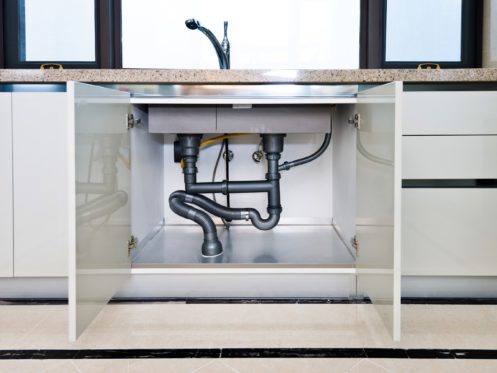Plumbing tape is a simple product used to seal threaded plumbing connections that do not have an in-built rubber seal. When these threaded plumbing connections are bound together, they create a watertight seal that will prevent leaks. Applying plumbing tape helps lubricate the connection, which makes threading smoother and prevents pipes from sticking together.
This comes in handy when it’s time to disassemble the joint. From this description, you might think that using plumbing tape is easy, but that is not the case. There is a right and wrong way to use plumbing tape. Here is the ultimate guide for how to use it.
Clean the Threads
The first step to successfully applying plumbing tape is to clean the threads on the pipes that you’re planning to seal even if they’re brand-new. Ensure that you get rid of any dirt, debris, or dust using a clean rag.
It is possible that even brand-new threads might not have been cleaned properly after coming off the machine. They might have some traces of oil and metal shavings from the manufacturing process, which might end up compromising the effectiveness of the plumbing tape. Also, the threads of older pipes might be covered in grease, grime, dirt, dust, and rust, so you’ll want to remove as much of that as you can.
Allow the Threads to Dry
If you’ve cleaned the threads using a cleaning liquid, it’s best to allow them to dry before applying plumbing tape to them. Plumbing tape is much more effective when used on dry surfaces compared to wet ones.
Apply the Plumbing Tape in the Right Direction
The key to creating a watertight seal using plumbing tape is knowing which direction to wrap the tape. Experts recommend that you wrap the plumbing tape around the pipe in the opposite direction to which the pipe will be turned.
Applying the plumbing tape this way ensures that the pipe is turned into the fitting and that the friction will tighten the tape to create a successful connection between the two objects.
Don’t Skimp on the Plumbing Tape
The whole idea behind using plumbing tape is to create a long-lasting seal between two plumbing fixtures. Therefore, when applying plumbing tape, do not skimp. Most plumbing experts recommend that you wrap the plumbing tape around a pipe about four to six times. This might sound excessive, but it will help you create a better seal and avoid any leaks.
Continue wrapping the tape until you reach the end of the threads. Additionally, ensure that the plumbing tape is pulled tightly as you wrap it so that it fits perfectly on the pipe.
Never Fray the Plumbing Tape
Just like most plumbing tools out there, all plumbing tape isn’t manufactured equally. There are some inexpensive plumbing tapes on the market that fray easily compared to others. Frayed plumbing tape is basically useless when it comes to plumbing repairs because it doesn’t coat the threads properly and can easily be caught by the female plumbing component.
Therefore, when shopping for plumbing tape, do not just go for the cheapest one in the store. It’s best to consult a plumber about which brand might be most suitable for your needs. If you find out that your plumbing tape frays easily, it’s best to return it.
After you’ve finished wrapping the plumbing tape, break it from the roll by simply gripping it with your fingers and by pulling it sharply because plumbing tape tears easily. Finally, smooth the loose end, and ensure that you tighten it around the wrapping. The plumbing fixture is now ready to be screwed onto the threaded pipe to create a watertight seal as you intended.
Applications of Plumbing Tape
Plumbing tape is used in applications involving gas pipe connections. However, this requires a special type of plumbing tape, usually colored yellow, and it is much thicker and denser than regular plumbing tape. It’s never advisable to use regular plumbing tape for gas pipe connection since it degrades easily, which is extremely dangerous and can lead to gas leaks.
Mostly, you can use plumbing tape in the same applications for which you would use pipe dope. Plumbing tape can basically be used with any threaded connections on different types of metal pipes as well as some plastic PVC pipes. There are a lot of places around the house that you can use plumbing tape, like to create watertight seals on shower arms and showerheads, in pipe-to-valve connections, and in pipe-to-coupling connections.
Here are some frequently asked questions that people who don’t often work with plumbing tape have.
Can Plumbing Tape Fail?
Yes, plumbing tape can fail if subjected to certain environmental conditions. For example, if you use plumbing tape in extremely hot or cold environmental conditions, it will end up becoming brittle and cracking, thus causing leaks along the threaded connection. Also, it’s important to note that plumbing tape ages with time, causing it to become brittle and to crack on its own.
In general, plumbing tape is designed for metal threaded connections like those found in faucets and valves made of copper, galvanized steel, or even brass. This makes plumbing tape suitable for fixing water pressure problems that are caused by leaks.
On the other hand, plumbing tape doesn’t do so well with some plastic pipes because once they get hot, the tape will melt and will leave you with a very big plumbing problem in your hands.
How Does You Remove Plumbing Tape?
When it comes to removing plumbing tape from a threaded connection, it’s best to wrap a rag around the plumbing fixture and try pulling it backward with your hand. You can also use sandpaper to remove the tape. However, ensure that you don’t damage the threading or the female plumbing fixture while you’re at it.
Is Plumbing Tape Waterproof?
Generally, plumbing tape isn’t intended to make any plumbing fixture waterproof. Therefore, most of the plumbing tapes sold on the market today are not waterproof. However, there is a Teflon variant that is able to provide you with a certain degree of water resistance since it works by creating a secondary seal between the two objects.
Is Plumbing Tape Reusable?
You can only reuse plumbing tape if you didn’t overstretch it the first time you were wrapping it around your plumbing fixtures. If you did, you’re better off buying a new roll because reusing overstretched plumbing tape won’t create the watertight seal that you’re looking for.
Is Plumbing Tape the Same as Teflon?
Plumbing tape is not the same as Teflon. Many people call plumbing tape “Teflon,” but in reality, Teflon is not a real product on its own. Teflon is the brand name of a nonstick substance, which is often used to describe plumbing tape. However, over the years, plumbing tape has informally adopted the name. Therefore, when visiting the hardware store, you can simply ask for Teflon tape because it generally refers to different types of plumbing tapes.
Are you looking for a reliable plumber in Temecula, Murietta, or Orange, CA, to give your plumbing fixtures a tune-up? Contact us today at We Care Plumbing, Heating & Air, and let us provide your Southern California home with the best heating, cooling, plumbing, and air quality services that you can get.







